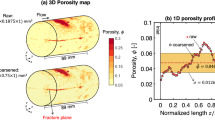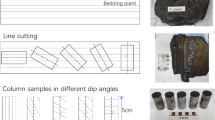Abstract
This paper demonstrates capabilities of low-field nuclear magnetic resonance (NMR) and microfocus X-ray computed tomography (μCT) in advanced, nondestructive, and quantitative characterization of pore types, producible porosity, pore structure, and spatial disposition of pore-fractures in coals. Results show that the NMR transverse relaxation time (T 2) at 0.5–2.5, 20—50, and >100 ms correspond to pores of <0.1 μm, >0.1 μm, and fractures, respectively. A much higher T 2 spectrum peak reflects a much better development of pores (or fractures) corresponding to the T 2, and vice versa. Three basic components in coals, i.e., the pores (or fractures), coal matrix, and minerals have their distinctive range of CT numbers. Among these, the CT number of pores is commonly less than 600 HU. The producible porosity, which is a determination of permeability, can be calculated by T 2 cutoff value (T 2C) of coal NMR. The coal pore structure can be efficiently estimated by the newly proposed “T 2C based model”. Finally, μCT scan was proven capable of modeling and spatial visualization of pores and fractures.
Similar content being viewed by others
References
Yao Y B, Liu D M, Tang D Z, et al. Reserving and recovering characteristics of coalbed methane in coal reservoirs in North China (in Chinese). Petro Exp Dev, 2007, 34: 664–668
Sing K S W. Characterization of porous materials: Past, present and future. Colloid Surface A, 2004, 241: 3–7
Yao Y B, Liu D M, Huang W H, et al. Research on the pore-fractures system properties of coalbed methane reservoirs and recovery of coalbed methane in Huainan and Huaibei coal-fields (in Chinese). J China Coal Soc, 2006, 31: 163–168
Yao Y B, Liu D M, Tang D Z, et al. Fractal characterization of adsorption-pores of coals from North China: An investigation on CH4 adsorption capacity of coals. Int J Coal Geol, 2008, 73: 27–42
Yao Y B, Liu D M, Tang D Z, et al. Fractal characterization of seep-age-pores of coals from China: An investigation on permeability of coals. Comput Geosci, 2009, 35:1159–1166
Suuberg E M, Deevi S C, Yun Y. Elastic behaviour of coals studied by mercury porosimetry. Fuel, 1995, 74: 1522–1530
Gane P A C, Ridgway C J, Lehtinen E, et al. Comparison of NMR cryoporometry, mercury intrusion porosimetry, and DSC thermoporosimetry in characterizing pore size distributions of compressed finely ground calcium carbonate structures. Ind Eng Chem Res, 2004, 43: 7920–7927
Yao Y B, Liu D M, Che Y, et al. Petrophysical characterization of coals by low-field nuclear magnetic resonance (NMR). Fuel, 2009, doi: 10.1016/j.fuel.2009.11.005
Yao Y B, Liu D M, Che Y, et al. Non-destructive characterization of coal samples from China using microfocus X-ray computed tomography. Int J Coal Geol, 2009, 80: 113–123
Coates G R, Xiao L Z, Prammer M G. NMR Logging Principles and Applications. Houston (Texas): Gulf Publishing Company, 1999. 1–76
Kevin M, Douglas M, Smith A. NMR technique for the analysis of pore structure: numerical inversion of relaxation measurements. J Colloid Interface Sci, 1987, 19: 117–126
Hodgkins M A, Howard J J. Application of NMR logging to reservoir characterization of low-resistivity sands in the gulf of Mexico. AAPG Bull, 1999, 83: 114–127
Wang W M, Sun D Q, Miao S, et al. The fundamental study on NMR logging (in Chinese). Well Log Tech, 1997, 21: 385–392
Wang X W, Xiao L Z, Xie R H, et al. Study of NMR porosity for terrestrial formation in China. Sci China Ser G-Phys, Mech Astron, 2006, 49: 313–320
Kenyon W E. Nuclear magnetic resonance as a petrophysical measurement. Nucl Geophys, 1992, 6:153–171
Karacan C Ö, Okandan E. Fracture/cleat analysis of coals from Zonguldak Basin (northwestern Turkey) relative to the potential of coalbed methane production. Int J Coal Geol, 2000, 44: 109–125
Van Geet M, Swennen R. Quantitative 3D-fracture analysis by means of microfocus X-ray computer tomography (μCT): An example from coal. Geophys Res Lett, 2001, 28: 3333–3336
Mazumder S, Wolf K H A A, Elewaut K, et al. Application of X-ray computed tomography for analyzing cleat spacing and cleat aperture in coal samples. Int J Coal Geol, 2006, 68: 205–222
Yakov V. A practical approach to obtain primary drainage capillary pressure curves from NMR core and log data. Petrophysics, 2001, 42: 334–343
Liu T Y, Xiao L Z, Fu R S, et al. Applications and characterization of NMR relation derived from sphere capillary model (in Chinese). Chin J Geophys, 2004, 47:663–671
Author information
Authors and Affiliations
Corresponding author
Rights and permissions
About this article
Cite this article
Yao, Y., Liu, D., Cai, Y. et al. Advanced characterization of pores and fractures in coals by nuclear magnetic resonance and X-ray computed tomography. Sci. China Earth Sci. 53, 854–862 (2010). https://doi.org/10.1007/s11430-010-0057-4
Received:
Accepted:
Published:
Issue Date:
DOI: https://doi.org/10.1007/s11430-010-0057-4




